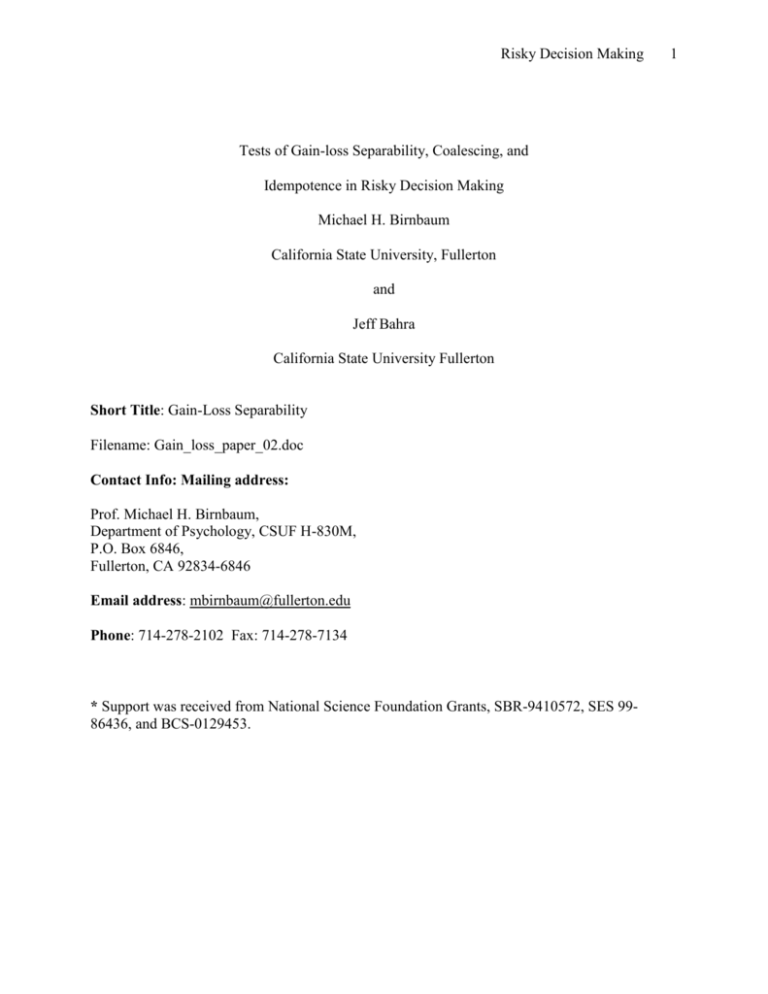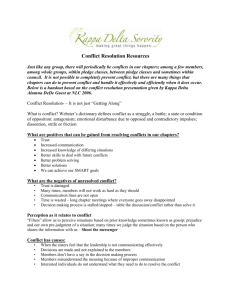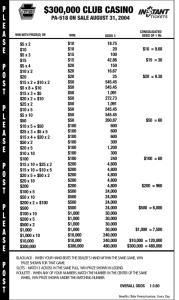G - psych.fullerton.edu.... - California State University, Fullerton
advertisement

Risky Decision Making Tests of Gain-loss Separability, Coalescing, and Idempotence in Risky Decision Making Michael H. Birnbaum California State University, Fullerton and Jeff Bahra California State University Fullerton Short Title: Gain-Loss Separability Filename: Gain_loss_paper_02.doc Contact Info: Mailing address: Prof. Michael H. Birnbaum, Department of Psychology, CSUF H-830M, P.O. Box 6846, Fullerton, CA 92834-6846 Email address: mbirnbaum@fullerton.edu Phone: 714-278-2102 Fax: 714-278-7134 * Support was received from National Science Foundation Grants, SBR-9410572, SES 9986436, and BCS-0129453. 1 Risky Decision Making 2 Abstract This experiment tested three properties of risky decision making:gain-loss separability, coalescing, and idempotence. Cumulative prospect theory satisfies all three properties, but TAX violates the first two. Indirect tests of idempotence did not require rejection of the property. Contrary to cumulative prospect theory, we found systematic violations of coalescing and observed that tests of gain-loss separability depended on how branches were split or coalesced. Birnbaum’s transfer of attention exchange model predicted choices better than did the cumulative prospect model. Risky Decision Making 3 Tests of Gain-loss Separability, Branch Splitting, Risk/Loss Attitudes, and Idempotence in Risky Decision Making Introduction This study is based upon work by Wu and Markle (2004) and extends their results. Their paper showed systematic violations of Gain-Loss Separability, which violate cumulative prospect theory and other rank-and sign-dependent utility theories in which gains and losses are evaluated and combined by a separable mechanism. Cumulative Prospect theory (Tversky & Kahneman, 1992) can be written as follows: n m CPU(G) [W (Pi ) W (Pi1 )]u(xi ) [W (Qj ) W (Qj 1 )]u(x j ) , i 1 (1) j 1 where Pi and Pi 1 are the probability of a loss being equal to or worse (lower) than xi and strictly lower than xi , respectively; Q j and Q j 1 are the probabilities of winning a (positive) prize of x j or more, and strictly more than x j , respectively. CPU (G ) is the utility (also called “value”) of the gamble in CPT. The weighting functions are further specified as follows: Pr W ( p) ( p (1 p) ) r P r 1 r and W ( p) ( p (1 p) ) 1 (2) CPT accounts for the Allais paradoxes and other evidence cited against EU by Tversky and Kahneman (1979) and Tversky and Kahneman (1992). However, it also implies coalescing and properties that can be deduced from coalescing, which have been disproved in previous studies. Coalescing is the assumption that it should not matter whether a gamble is presented in split or coalesced form. For example, consider the following choice: Risky Decision Making A: 50 black marbles to win $100 4 B: $45 for sure 50 white marbles to win $0 According to the property of coalescing, this two-branch gamble A ($100,0.5;$0,0.5) is equivalent to the three-branch gamble that can be created by splitting the .5 branch to win $100 into two splinters, as follows: A ($100,0.25;$100,0.25;$0,0.5) . Gamble A is the “coalesced form” of the gamble, and A is one of the many possible “split” forms of A. Thus, people should make the same choice between A and B as they did between A and B, in the following choice: A’: 25 black marbles to win $100 B: $45 for sure 25 blue marbles to win $100 50 white marbles to win $0 A number of recent studies, however, have presented evidence against CPT, since people do not treat the coalesced and split forms as equivalent (Birnbaum, 2004a; 2004b). We can further distinguish two types of coalescing in three branch gambles. Upper coalescing is defined as follows: G (x, p; x,q; z,1 p q) G ~ G (x, p q; z,1 p q) Lower coalescing is defined as follows: G ( x, p; y, q; y,1 p q) G ~ G ( x, p; y,1 p) When the term “coalescing” is used without modification, it refers to the assumption of both forms. CPT implies both forms of coalescing. This study will compare predictions of CPT against those of Birnbaum’s TAX model, which does not satisfy coalescing. It tests three properties: coalescing, gain-loss separability, and idempotence. The study also replicates tests of risk aversion and loss aversion to check that our participants and experimental context are compatible with those of previous studies. Risky Decision Making 5 Gain-Loss Separability is implied by CPT (Wu & Markle, 2004). The property can be defined as follows for gambles containing mixed consequences (i.e., both gains and losses). If both the positive and negative parts of the gambles favor G over F, then people should not prefer F over G. More formally, let G ( x1 , p1 ; x2 , p2 ;; xn , pn ; y m , qm ;; y 2 , q2 ; y1 , q1 ) where the outcomes are ranked such that x1 x2 xn 0 y m y 2 y1 . Now break G into positive and negative subgambles, as follows: G (0, i1 pi ;y m , pm ; ;y 2 ,q2 ;y1 ,q1 ) and G (x1 , p1 ; x2 , p2 ; ; x n , pn ;0, i 1 q i ) . n m Gain-Loss Separability holds that if G F and G F then G F. Because data are probabilistic, we consider three stochastic definitions of the property: Weak GLS will refer to the property that if P( G F )>1/2 and P( G F ) > 1/2, then P( G F. )>1/2, where P represents choice probability. Strong GLS refers to the property that if the same premise holds, then P( G F. ) will exceed the larger of the two choice probabilities, and moderate GLS assumes it will exceed the smaller of the two. Wu and Markle (2004) reported systematic violations of Weak GLS, illustrated in the following three choices: No. 1 2 G G+: G-: .25 chance at $1600 F F+: .25 chance at $2000 .25 chance at $1200 .25 chance at $800 .50 chance at $0 .50 chance at $0 .50 chance at $0 F-: .50 chance at $0 .25 chance at $-200 .25 chance at $-800 %G TAX CPT 72 551.8 > 551.3 < 496.6 601.4 -275.9> -437 < -358.7 -378.6 60 Risky Decision Making .25 chance at $-1600 3 G: 6 .25 chance at $-1000 .25 chance at $1600 F: .25 chance at $2000 .25 chance at $1200 .25 chance at $800 .25 chance at $-200 .25 chance at $-800 .25 chance at $-1600 .25 chance at $-1000 38 -300 < -178.6 < -280 -107.2 A significant majority of respondents preferred F to G in Choice 3, replicating the pattern found by Levy & Levy (2002), which is consistent with CPT as fit to prior data (Wakker, 2003). To test Gain-Loss Separability, Wu and Markle decomposed G and F into their gain and loss sub-gambles. These choices are shown with their respective choice percentages. Contrary to GLS, the majority (72%) preferred G+ over F+; 60% preferred G- over F-; but 62% chose F over G (Wu & Markle, 2004). Although these violations of GLS refute CPT, they are consistent with the special TAX model of Birnbaum and Chavez (1997), with parameters estimated from previous data. For positive consequences, the TAX model can be written for gamble G = (x1, p1; x2, p2; ... xj, pj; ...; xi, pi; ...; xn, pn), with n distinct branches, where the consequences are ordered such that x1 ≥ x2 ≥ ... xi ≥ ...≥ xn. A “special case” of the TAX model (Birnbaum & Chavez, 1997) in which all weight transfers are the same proportion of probability weight can be written as follows: n TAX(G) u(xi )[t( pi ) i 1 n (n 1) j i 1 t(pi ) n t( p ) (n 1) i 1 t(p )] j j 1 (3) i i 1 where the configural weight parameter is . Different values of are permitted for gambles configured of all negative or mixed consequences. If = 0, and t (p) = p, this model reduces to Risky Decision Making 7 EU. The effect of is to transfer weight from one branch to another, representing the attention directed to different branches. To explain risk aversion in the TAX model, it is assumed that weight is taken from branches with higher valued consequence and given to branches with lower valued consequences. In this paper, we use previously estimated parameters from Birnbaum (1999a), t ( p) p .7 , = 1, u(x) = x, for $100 x $100 . (The equation is written with branches ordered as in CPT; and the value of = 1 here corresponds to = -1 in Birnbaum (1999a) and previous articles. The certainty equivalent (CE) of a gamble is the amount of cash that is indifferent to the gamble. Gambles composed of strictly positive consequences and mixed consequences are calculated by the expression above. This assumption represents both risk aversion and loss aversion by same weighting mechanism, and assumes that both are governed by the same value of . One additional assumption is needed to handle gambles of purely negative consequences, however. For gambles composed of strictly negative consequences, the reflection hypothesis is assumed. Thus, predictions for strictly negative gambles are made by substituting absolute values for the consequences in Equation 3 with the same value of . The result is multiplied by negative one. The TAX model, with the assumptions stated, reproduces the violation of GLS described above. According to this model, choices systematically violate gain-loss separability and coalescing (except in the special case where the model simplifies to EU). Indeed, as fit to previous data, the TAX model reproduces the modal choices reported by Wu and Markle (2004), since CE(G+)>CE(F+); CE(G-) > CE(F-), and CE(G)<CE(F), respectively. It is interesting that it Risky Decision Making 8 is not the choice between G and F where TAX and CPT disagree, but in the choices of the 3branch subgambles. Note that this property of gain-loss separability involves three choices, where two of them are between three branch gambles and one is between two four-branch gambles. Perhaps coalescing plays a role in this test. That is the issue explored in this study. To show the connection with coalescing, we further simplify the example of Wu and Markle. Note that example in Choices 1, 2, and 3 can be compared to choices 4, 5, and 6 below: No. 4 5 G G+: G-: .25 to win $100 F F+: .25 to win $50 .25 to win $0 .25 to win $50 .50 to win $0 .50 to win $0 .50 to lose $0 F -: .25 to lose $50 7 G: G’: .25 to win $100 20.6 -20.6 -13.8 -25 -25 -15.5 -34.5 .25 to win $100 F: .25 to win $50 .25 to win $0 .25 to win $50 .25 to lose $50 .25 to lose $0 .25 to lose $50 .25 to lose $100 .25 to win $100 13.8 .25 to lose $0 .25 to lose $50 6 .50 to lose $0 TAX F’: .50 to win $50 .25 to win $0 .25 to lose $0 .50 to lose $50 .25 to lose $100 This study will test Gain-Loss Separability in both coalesced and split forms, based on this analogy with the study of Wu and Markle. In addition, the design will permit a specific test of indifference between G and F in the split form (Choice 6), implied by TAX model as fit to Risky Decision Making previous data, as well as a test of the same choice in coalesced form (Choice 7). In summary, CPT implies no violations of GLS, but TAX implies a violation of strong GLS in Choice 6 and of weak GLS in Choice 7. Idempotence is the assumption that if the consequence is x no matter what event occurs, that the gamble is indifferent to x. Idempotence can be written as follows: G (x, p1 ; x, p2 , ; x, pn ) G ~ x . “One aspect of the utility of gambling may evidence itself in failures of idempotence, i.e., when all chance outcomes give rise to the same consequence the `gamble' may not be indifferent to its common consequence. Under the assumption of segregation, such gambles can be expressed as the joint receipt of the common consequence and what we call `an element of chance', namely, the same gamble with the common consequence replaced by the status quo. Generalizing, any gamble is indifferent to the joint receipt of its element of chance and a certain consequence, which is called the `kernel equivalent' of the gamble. Under idempotence, the kernel equivalent equals the certainty equivalent.” (Luce & Marley, 2000). CPT and TAX both satisfy idempotence, but theories that allow a utility of gambling need not. Method Participants completed this study as two parts in a series of 13 self-contained decision tasks. This experiment consisted of 21 choices between pairs of gambles, which were presented twice, separated by five other similar tasks that required a total of approximately 25 min. Participants viewed the instructions and stimuli via the WWW, and working at their own paces, completed the series of 13 tasks (including the two parts that formed this study) in about one to one and one-half hours. 9 Risky Decision Making 10 Each choice was displayed as in the following example: 1. Which do you choose? A: 50 black marbles to win $100 50 red marbles to lose $100 OR B: 50 green marbles to win $1 50 yellow marbles to lose $1 Each gamble was described in terms of a container holding exactly 100 marbles of different colors, from which one marble would be drawn at random and the color of that marble would determine the gamble’s prize. In the choice illustrated above, gamble A is a 50-50 chance to either win $100 or to lose $100, and gamble B represents a 50-50 chance to win $1 or lose $1. Participants were instructed to click the button beside the gamble that they would prefer to play in each choice, knowing that some participants would receive the prize of one of their chosen gambles. They were informed that lucky participants selected from this task would receive $100 plus the consequence of one of their chosen gambles. They could thus win up to $200 or end up with as little as $0. (Prizes were awarded as promised to 3(6?) people from the series of studies.) Experimental Design Table 1 shows the eight choices used to test gain-loss separability and coalescing. Table 2 shows the nine choices used to test risk attitude, loss attitude, and idempotence. Insert Tables 1 and 2 about here. The complete instructions and materials can be viewed at the following URLs: HTTP://psych.fullerton.edu/mbirnbaum/decisions/gain_l_min_100.htm HTTP://psych.fullerton.edu/mbirnbaum/decisions/ gain_l_min_100_1.htm Risky Decision Making 11 5.2. Participants Participants were 178 undergraduates recruited from the “subject pool” in California State University, Fullerton. About half of the participants were tested on Internet-connected computers in the lab, and the others completed the studies outside the lab via the WWW. There were 137 females, 41 males, and 71% were younger than or equal to 19 years of age; 93% were younger than or equal to 22 years. Some additional participants were tested who either did not complete both repetitions or who were unreliable. Data of those who violated transparent dominance more than half the time or who agreed with their own choices less than half the time (between repetitions) are not included in this report, but the conclusions are not altered by inclusion or exclusion of those data. Results Table 1 shows the percentage that chose the second gamble in each test of gain-loss separability and coalescing. Choice 15 is the same as Choice 9, except for coalescing. Similarly, Choices 13 and 5, 19 and 11, and 17 and 7 differ only in whether branches are split or coalesced. CPT predicts that there should be no difference due to splitting or coalescing. The TAX model, however, with previously estimated parameters predicts that people should prefer G over F in Choice 15, but should choose F over G in Choice 9. Table 1 shows that 71% of participants preferred G in Choice 15, but only 37% chose G in Choice 9, consistent with the TAX model. Similarly, significantly more people (66%) chose G in 13, where two branches to lose $0 were split, than did in Choice 5 (31%), where the two “good” branches were coalesced. Choices 15, 13, and 19 test Gain-Loss Separability in the split form, and Choices 9, 5, and 11 test the same property in the coalesced form. Because 71% choose G over F in Choice 15 and 65% chose G over F in Choice 13, we expect that at least 71% should choose G over F according Risky Decision Making 12 to strong gain-loss separability. Instead, only 52% chose G over F in Choice 19. A very different picture emerges in the coalesced form, where 63% majority now chooses F over G , 69% choose F over G , and 76% choose F over G, consistent with gain-loss separability. But according to CPT, we can ignore coalescing, so an investigator would be allowed to combine Choices 15, 13, and 11, with 71%, 65%, and 24%, strongly in violation. So, the directions of preference and the conclusions regarding gain-loss separability are affected by whether the gambles are presented in split or coalesced form. According to the TAX model, there should have been indifference between F and G in Choice 19, and the data do not require rejection of the hypothesis that the choice proportion is ½. Table 2 assessed risk and loss attitudes and idempotence. Choices 12 and 16 differ only in that the two branches to win $50 in Choice 12 have been coalesced to one branch in Choice 16, providing an indirect test of idempotence. CPT and TAX imply that there will be no change between Choices 12 and 16. The results indicate that 67% of participants preferred S in Choice 12 and 69% preferred S in Choice 16, consistent with idempotence. The finding that about twothirds of the participants preferred the “safe” over the “risky” gamble with equal expected value indicates that these participants exhibited risk aversion, consistent with typical results. Choice 20 uses an even smaller value of sure cash and significantly more than half (60%) still prefer the “safe” alternative of $45, even though the expected value of the risky gamble is $50. Choices 6 and 10 test loss aversion and idempotence. By idempotence, the preference should be the same in Choices 6 and 10, where the figures are 37% and 31%. Consistent with the reflection hypothesis, the majority are risk-seeking for these losing gambles, 63% and 69% preferring to take a chance on the gamble rather than accept the sure loss of equal expected value. Risky Decision Making 13 Choices 8 ,18 and 21 are tests of loss aversion. In Choice 8, a slight majority of 53% favors the certainty of neither winning nor losing to a 50-50 gamble to either win or lose $100. Recall that these participants are playing with “house” money, and are less “loss averse” than participants who make hypothetical choices involving their own money as for example, in Tversky and Kahneman (1992), where participants are strongly loss averse. Choice 18 was originally designed as a test of idempotence, but during the experiment, we found that we had unintentionally tested a type of consequence framing effect. The initial way to describe a consequence of $0 was described as “sure thing to win $0”. With this wording, 62% favored the risky gamble over a sure thing to win $0. However, with the more neutral wording of “no change for sure”, 52% preferred the sure thing. When the sure thing was lose $5, participants were still approximately indifferent between the gamble and sure loss. These participants were less “loss averse” than is usually observed when participants make decisions as if they were for their own money. [We need to add statistics to results] Discussion The results of this study indicate that the TAX model is able to predict people choices better than the CPT model when testing gain-loss separability and branch splitting. Both theories however are almost identical in their ability to predict choices of idempotence as well as risk and loss attitudes. Testing risk and loss attitudes revealed that participants preferred the safe gambles over the risky ones. The study also shows that for losing gambles the majority of participant’s exhibit risk seeking behavior. When testing gain-loss separability and branch splitting the direction of preference and the conclusion regarding gain-loss separability is affected by whether the gambles are presented in split or coalesced form. Risky Decision Making 14 These results show that the results of tests of decision models can be affected by whether gambles are presented in split or coalesced form. Our results show that we could either conclude that Gain loss separability was satisfied, or strongly violated depending on how splitting and the gain-loss separability test was constructed. It is unclear to us if the violations of gain loss separability represent a new source of violation of CPT, or if they are the result of violations of coalescing. Limitations of this study where? Loss aversion less strong here. “house money” maybe that makes people more risktaking. Wu and Markle… New ideas? What is going on here? Are these testable? If so, how to test? Risky Decision Making 15 References Birnbaum, M. H. (1999a). Paradoxes of Allais, stochastic dominance, and decision weights. In J. Shanteau, B. A. Mellers, & D. A. Schum (Eds.), Decision science and technology: Reflections on the contributions of Ward Edwards (pp. 27-52). Norwell, MA: Kluwer Academic Publishers. Birnbaum, M. H. (1999b). Testing critical properties of decision making on the Internet. Psychological Science, 10, 399-407. Birnbaum, M. H. (2004a). Causes of Allais common consequence paradoxes: An experimental dissection. Journal of Mathematical Psychology, 48(2), 87-106. Birnbaum, M. H. (2004b). Tests of rank-dependent utility and cumulative prospect theory in gambles represented by natural frequencies: Effects of format, event framing, and branch splitting. Organizational Behavior and Human Decision Processes, 95, 40-65. Birnbaum, M. H., & Chavez, A. (1997). Tests of theories of decision making: Violations of branch independence and distribution independence. Organizational Behavior and Human Decision Processes, 71(2), 161-194. Kahneman, D., & Tversky, A. (1979). Prospect theory: An analysis of decision under risk. Econometrica, 47, 263-291. Levy, H. & Levy, M. (2002). Prospect theory, much ado about nothing? Management Science, 48, 1334-1349. Luce, R. D. (1990). Rational versus plausible accounting equivalences in preference. judgment. Psycholgical Science, 1, 225-234. Luce, R. D. (2000). Utility of gains and losses: Measurement-theoretical and experimental approaches. Mahwah, NJ: Lawrence Erlbaum Associates. Risky Decision Making 16 Luce, R. D., & Fishburn, P. C. (1991). Rank and sign-dependent linear utility models for finite first order gambles. Journal of Risk and Uncertainty 4, 29-59. Luce, R. D., & Marley, A. A. (2000). On elements of chance. Theory and Decision 49, (2) 97126. Lopes, L. L., & Oden, G. C. (1999). The role of aspiration level in risky choice: A comparison of cumulative prospect theory and SP/A theory. Journal of Mathematical Psychology, 43, 286-313. Tversky, A., & Kahneman, D. (1992). Advances in prospect theory: Cumulative representation of uncertainty. Journal of Risk and Uncertainty, 5, 297-323. Wakker, P. (2003). The Data of Levy and Levy (2002), "Prospect Theory: Much Ado about Nothing?" Support Prospect Theory. Management Science, 49, 979-981. Wu, G., & Markle, A. B. (2004). An empirical test of gain-loss separability in prospect theory. Working Manuscript, 06-25-04., Available from George Wu, University of Chicago, Graduate School of Business, 1101 E. 58 th Street, Chicago, IL 60637, http://gsbwww.uchicago.edu/fac/george.wu/research/abstracts.html. Risky Decision Making 17 Table 1. Tests of Gain-loss Separability and Branch Splitting No. Choice First Gamble, F 15 9 13 5 19 11 17 7 Second Gamble, G 25 black to win $100 25 blue to win $50 25 white to win $0 25 blue to win $50 50 white to win $0 50 white to win $0 25 black to win $100 50 blue to win $50 75 white to win $0 50 white to win $0 50 white to lose $0 50 white to lose $0 25 pink to lose $50 25 white to lose $0 25 pink to lose $50 25 red to lose $100 50 white to lose $0 75 white to lose $0 50 pink to lose $50 25 red to lose $100 25 black to win $100 25 blue to win $50 25 white to win $0 25 blue to win $50 25 pink to lose $50 25 white to lose $0 25 pink to lose $50 25 red to lose $100 25 black to win $100 50 blue to win $50 25 white to win $0 25 white to lose $0 50 pink to lose $50 25 red to lose $100 25 black to win $100 25 blue to win $50 25 white to win $0 25 blue to win $50 25 white to lose $0 25 pink to lose $50 25 red to lose $100 25 pink to lose $50 25 black to win $100 50 blue to win $50 50 white to win $0 50 pink to lose $50 25 red to lose $100 Prior TAX %G F Prior CPT G F G 13.8 20.6 24.6 18.7 21.1 16.7 24.6 18.7 -20.6 -13.8 -20.4 -24.8 -16.7 -21.1 -20.4 -24.8 -25 -25 -8.8 -15.3 -15.5 -34.5 -8.8 -15.3 -30 -20 -12.8 -11.2 -31.9 -16.7 -12.8 -11.2 0.71 0.37 0.65 0.31 0.52 0.24 0.57 0.48 Risky Decision Making 18 Table 2. Tests of Risk Attitude, Loss Attitude, and Idempotence. No. Choice R 12 16 20 6 10 14 8 18 21 %R S 50 black to win $100 50 blue to win $50 50 white to win $0 50 green to win $50 50 black to win $100 100 blue to win $50 50 white to win $0 (win $50 for sure) 50 black to win $100 100 green to win $45 50 white to win $0 (win $45 for sure) 50 white to lose $0 50 pink to lose $50 50 red to lose $100 50 orange to lose $50 50 white to lose $0 100 pink to lose $50 50 red to lose $100 (lose $50 for sure) 50 white to lose $0 100 orange to lose $55 50 red to lose $100 (lose $55 for sure) 50 black to win $100 50 white to win $0 50 red to lose $100 50 white to lose $0 50 black to win $100 100 white marbles to win/lose $0 50 red to lose $100 (no change for sure) (before: it was win $0 for sure. 50 black to win $100 100 yellow to lose $5 50 red to lose $100 (lose $5 for sure) Prior TAX S R Prior CPT S R 33.3 50 37.4 50 33.3 50 37.4 50 33.3 45 37.4 45 -33.3 -50 -40.8 -50 -33.3 -50 -40.8 -50 -33.3 -55 -40.8 -55 -33.3 0 -22.3 0 -33.3 0 -22.3 0 -33.3 -5 -22.3 -5 0.67 0.69 0.60 0.37 0.31 0.32 0.53 .38 win 0, .52 win/lose 0.48







